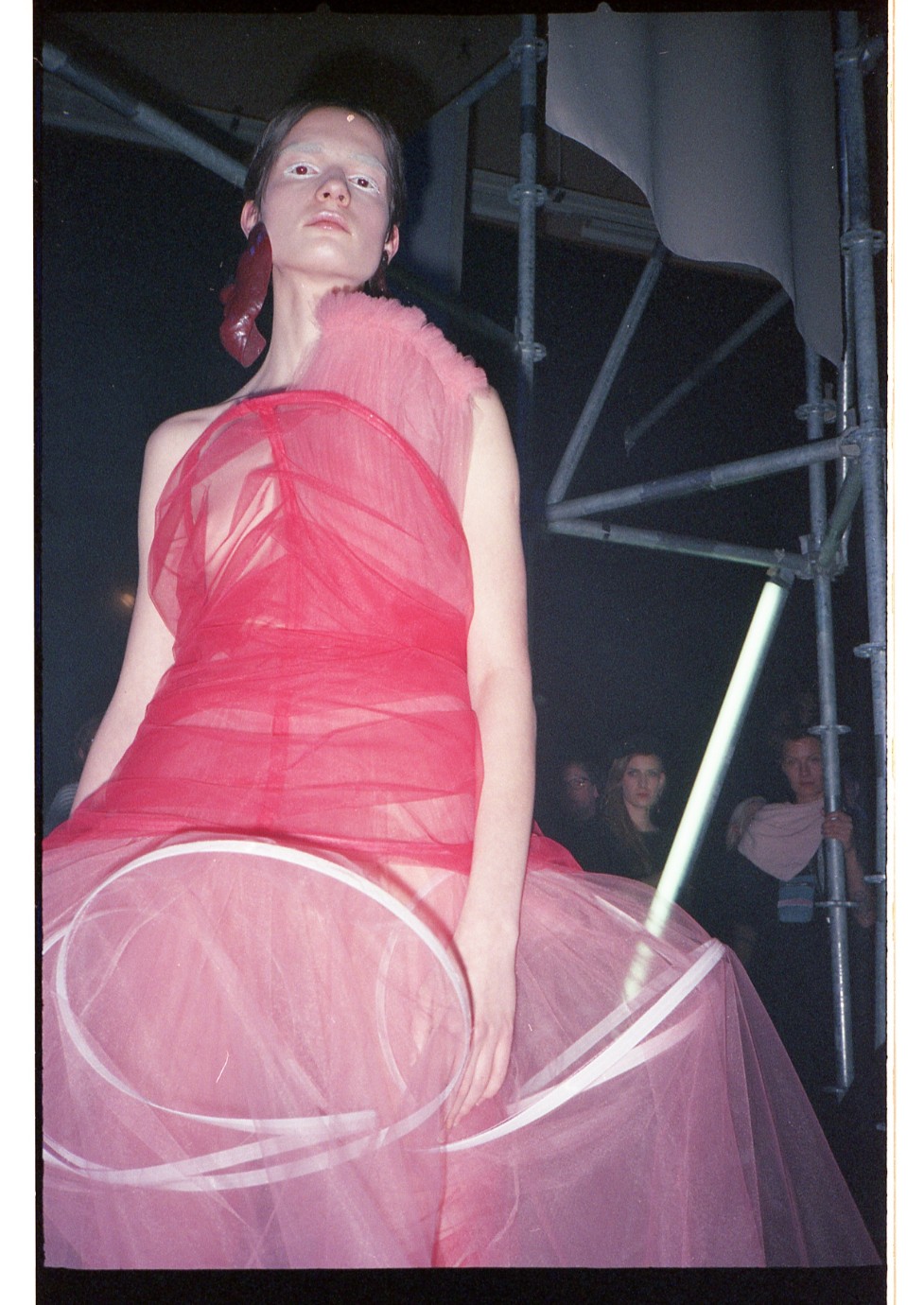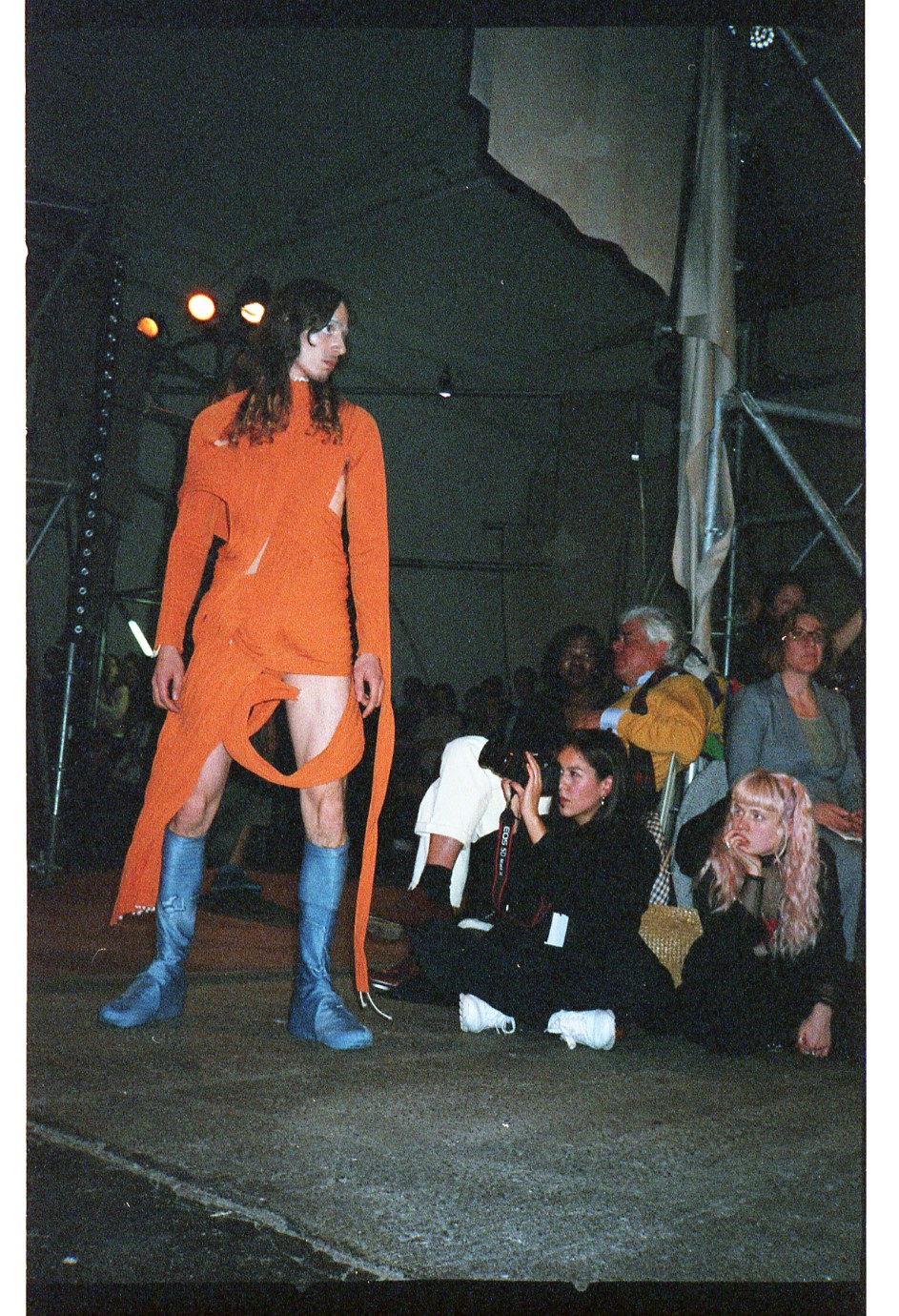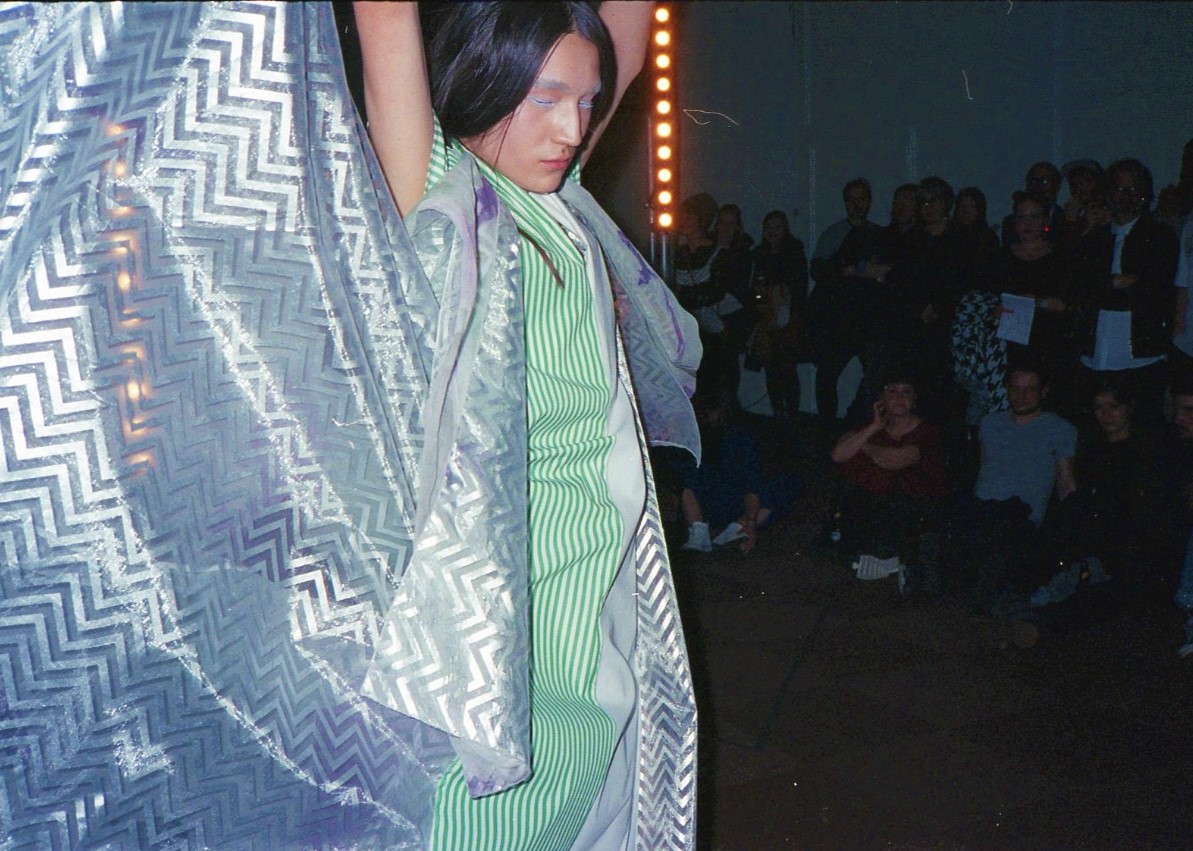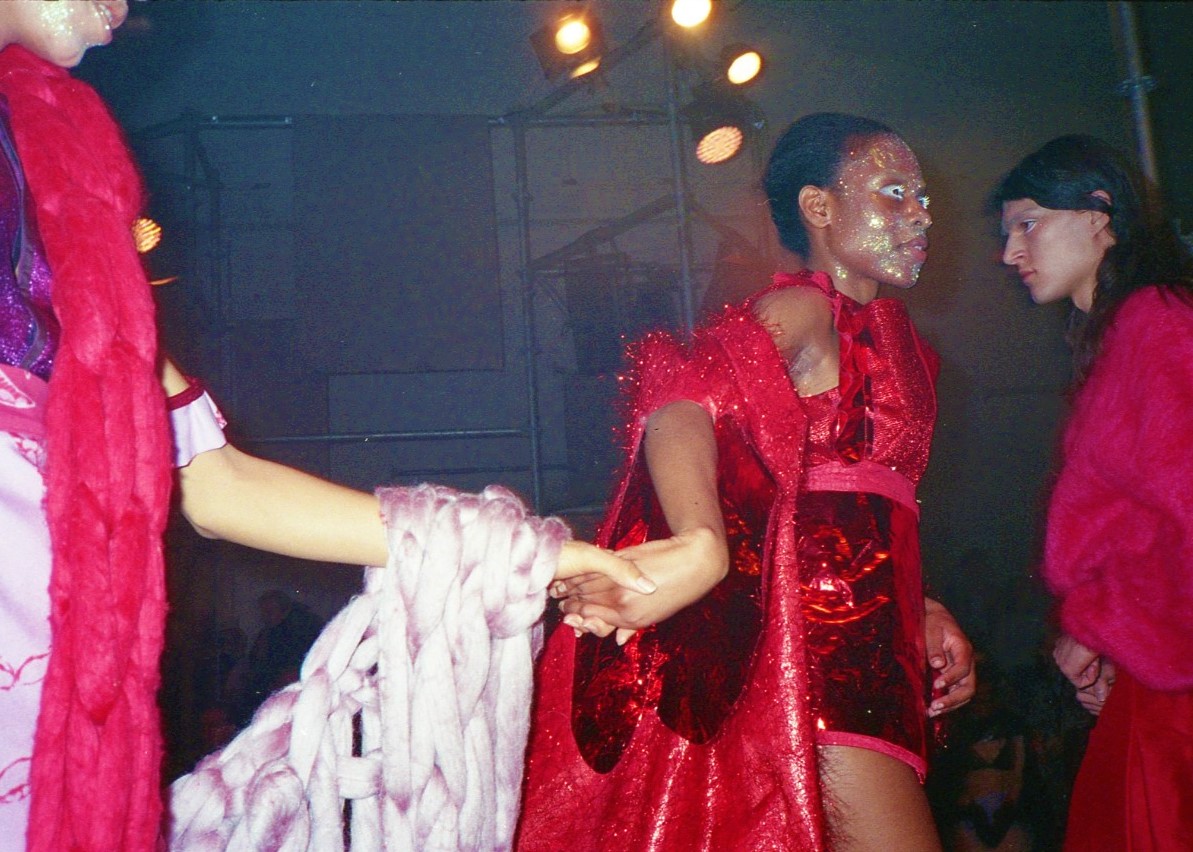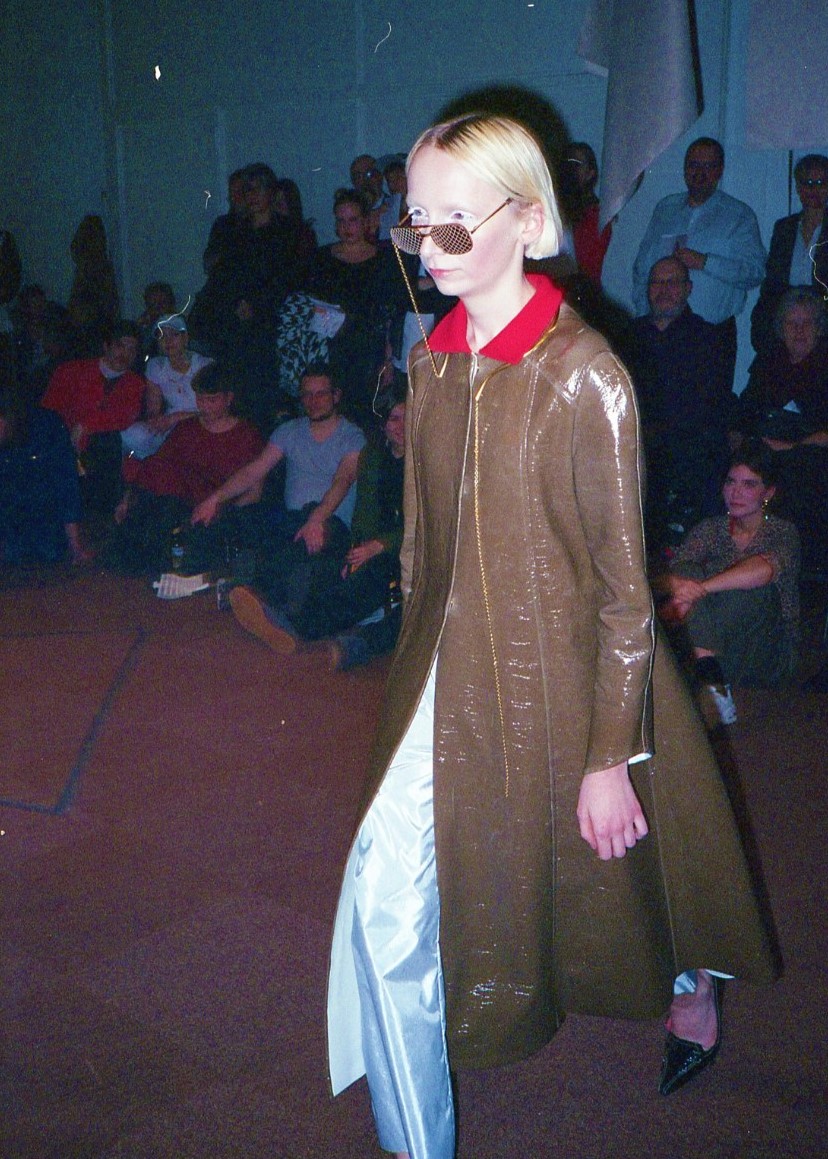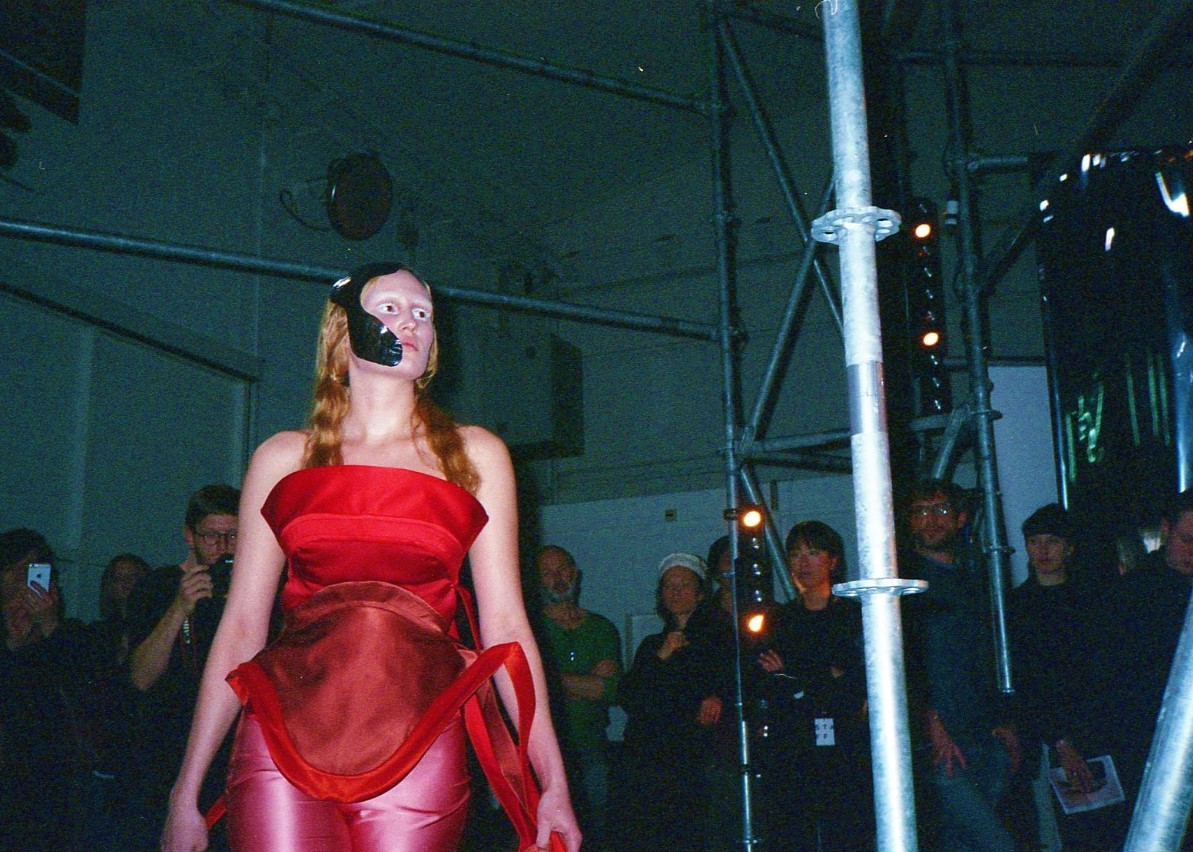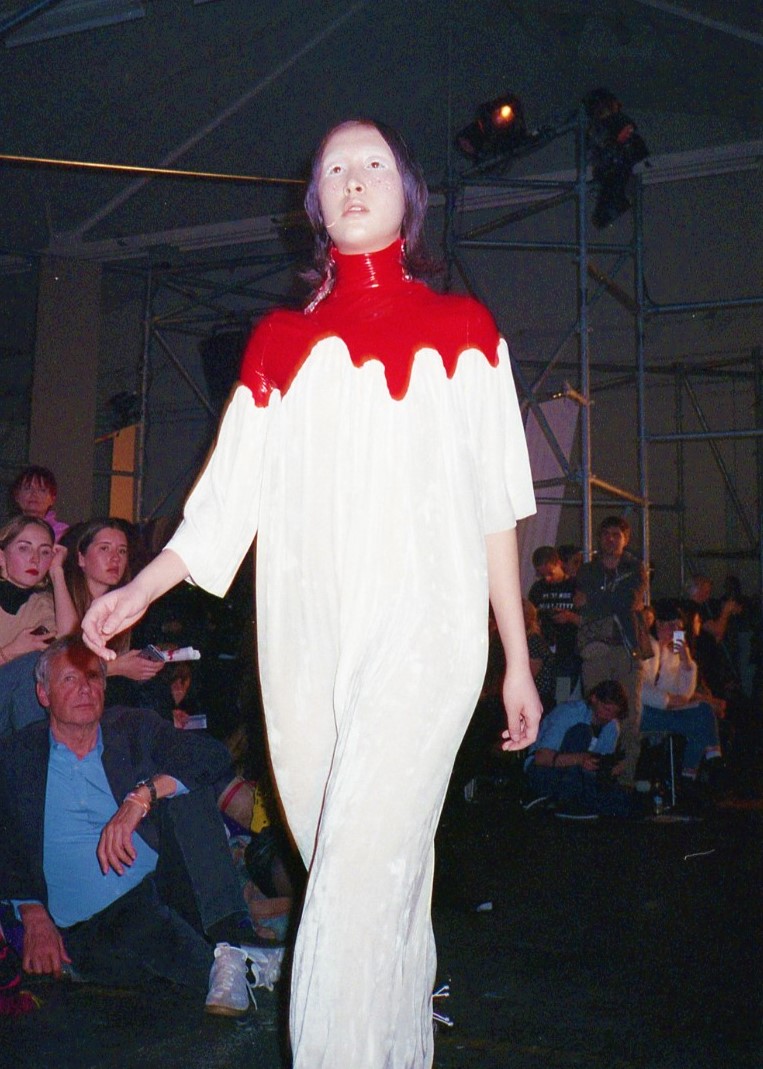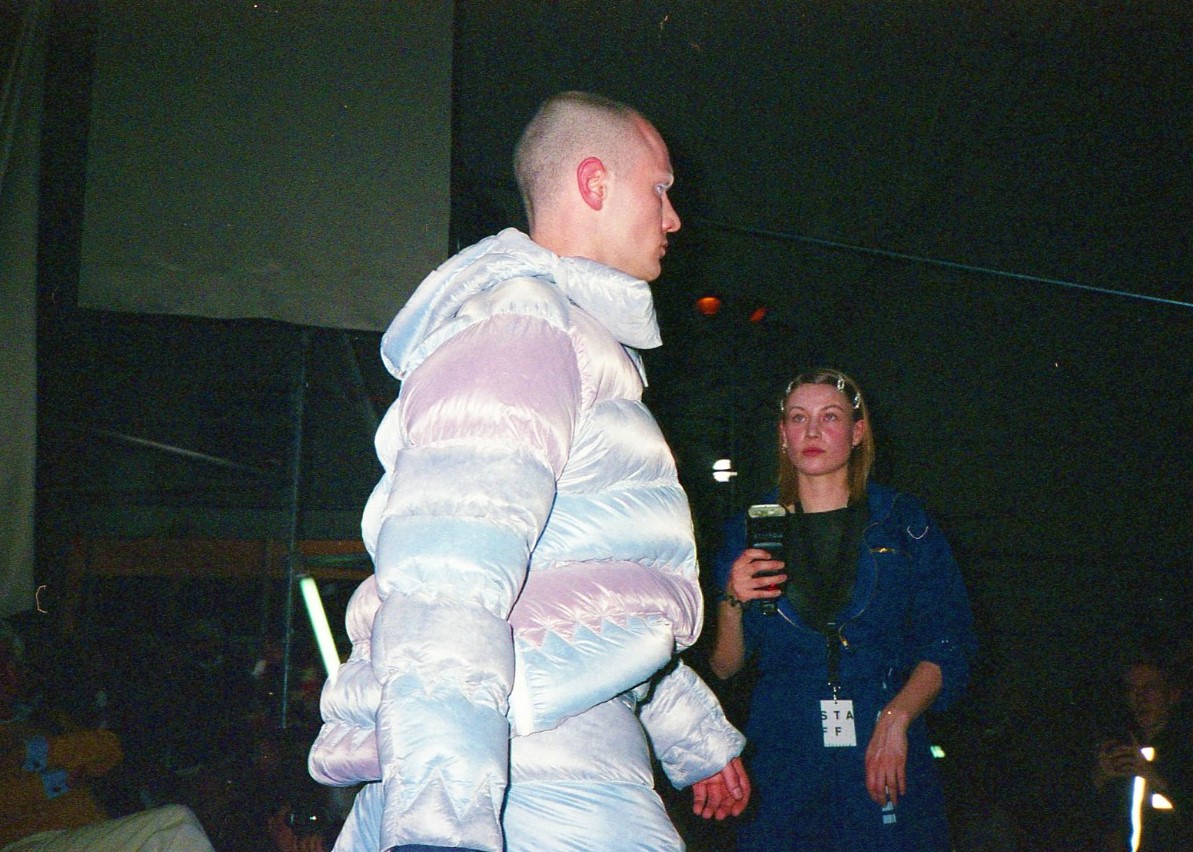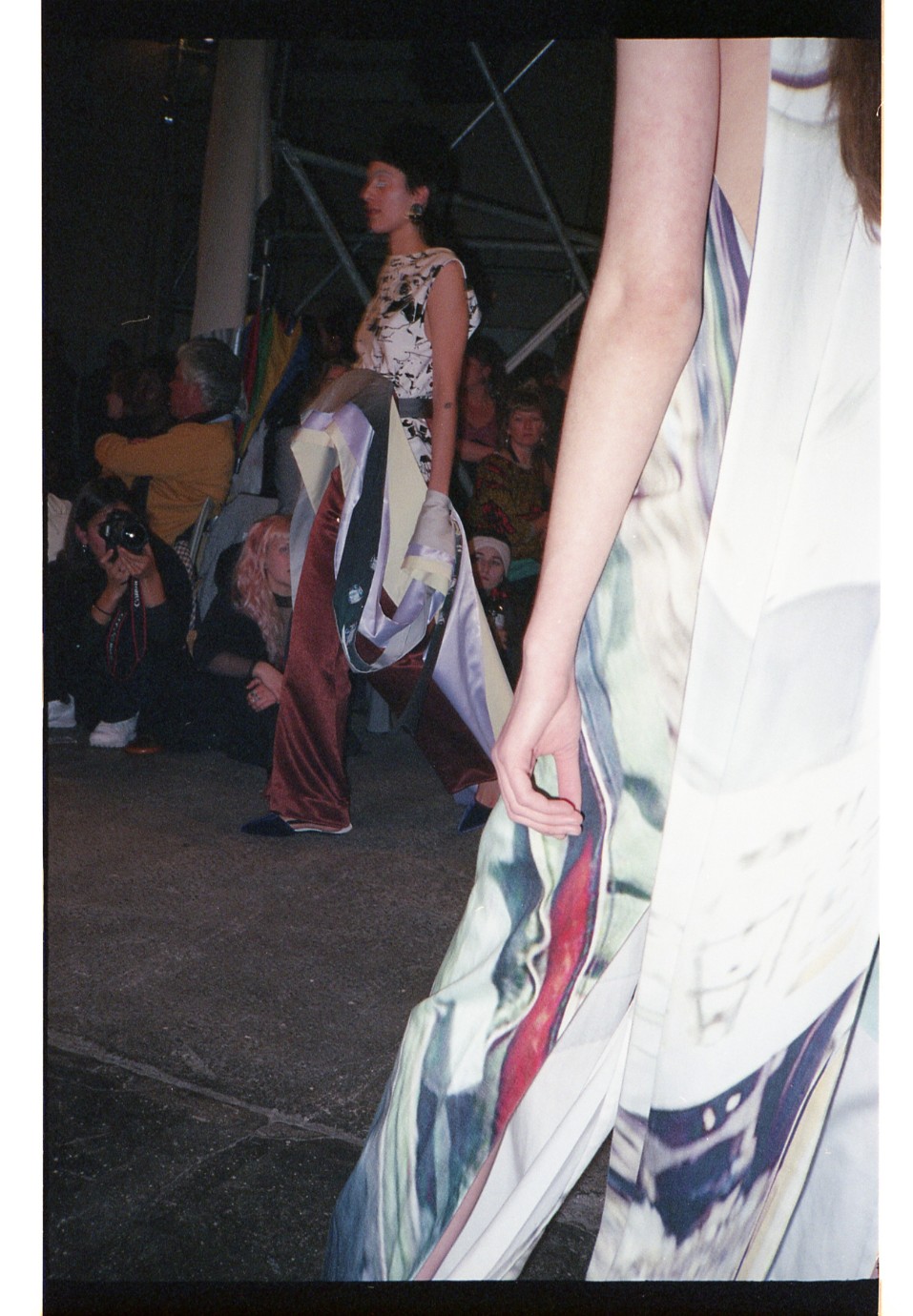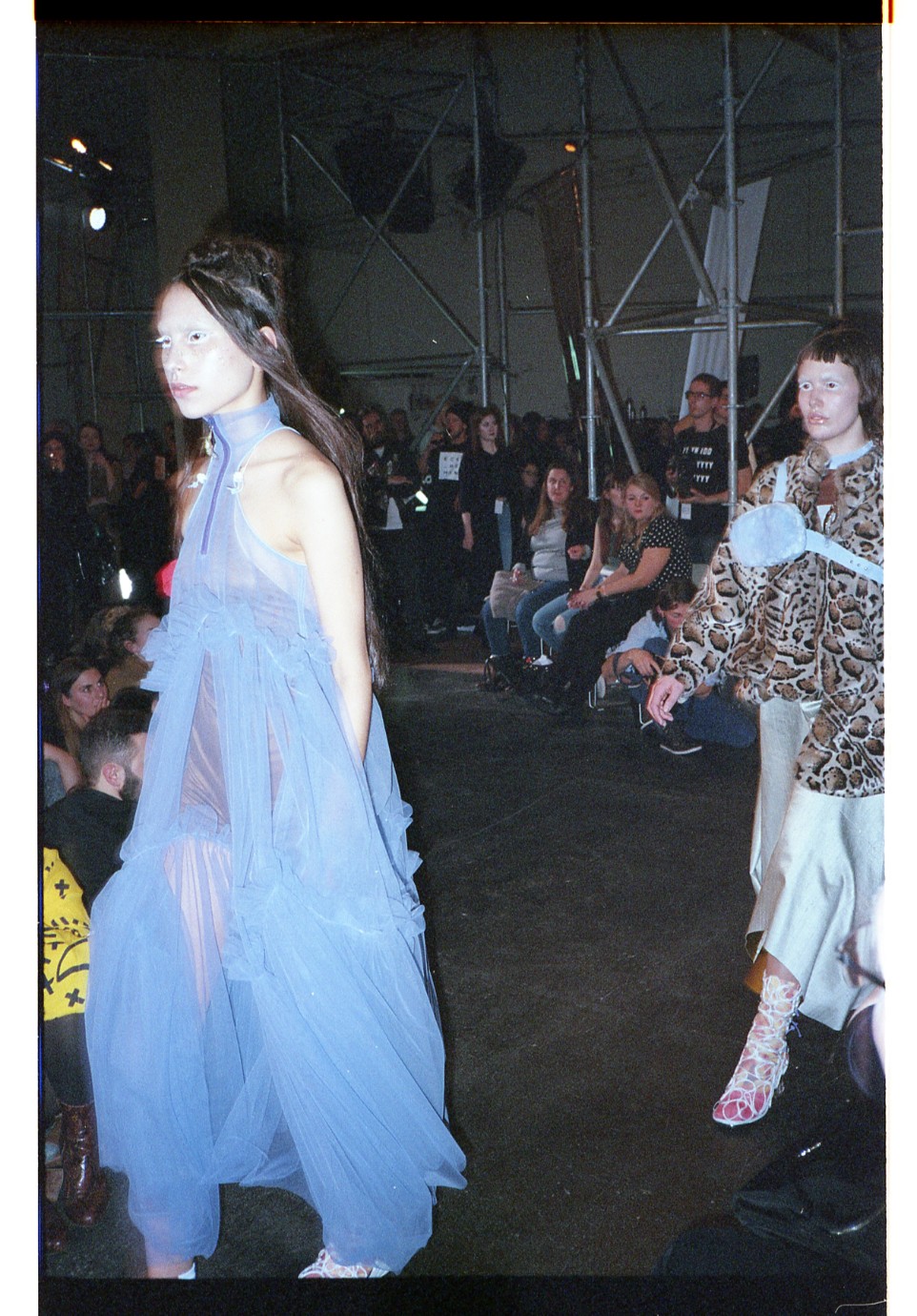Walking into the building, there was no catwalk. Instead, visitors found a maze of scaffolding and neon lights through which the diversely cast models would later run, skip and dance ‒ a nightmare for the photographers, who could be seen chasing models to get a shot, but so much fun for anyone watching! Equally fascinating was the event that took place before the show. Food for Thought traditionally gives students an opportunity to speak with press and industry professionals in a more intimate, convivial setting. Up until the invitation made out of edible paper, every part of the event was carefully curated, and the graduates themselves were happy to join the pre-show fun. They had already presented their collections to a jury in January, when they were asked to build room-sized installations with the help of industrial design and architecture students.
Priska Morger, artistic director of the BA and MA, explained the reasoning behind this particular focus on performance and communication: “I started my career at Raf Simons, and for him, it was never just about the clothes. He taught me that a vision should be expressed through every single part of the communication. That’s what I’m trying to give my students as well.” The results are both stunning and delicious, but raises the question whether a focus on presentation distracts from the actual garment making. Maya Christofori, one of this year’s graduates, explained that it’s not necessarily about being able to do it all, but about understanding the effort it takes: “It’s important to know how much energy goes into communicating a collection. You better be nice to your graphic designer, those things aren’t done in a second. It’s about being thankful for what other people do for you.”
It goes to show that a teacher’s intent is nothing without a student’s lived experience. That is why, as part of a new series, we will be asking students and graduates to explain, analyze, comment and critique their school’s official communications. Having an extended school philosophy is great, but does it work in practice?
The Institute of Fashion-Design lives and teaches a holistic understanding of fashion.
“I chose this MA course not just because it is the best fashion school in Switzerland, but because it integrates scenography and industrial design. I worked a lot with other students from different disciplines. For me, collaboration is the future of how we work in the industry. For example, for my final presentation at the institute, I collaborated with an architect, a product designer, and graphic design students. The result is a lot better than I could ever imagine.” ‒ Jacqueline Loekito
“Another example is that we are not asked to define what we want to specialize in. You don’t have to check a box that says “menswear”, “womenswear” or “accessories”, our school is too small for that. You can make a menswear collection the first semester, then switch to womenswear, then do a mixed collection. It’s up to you!” ‒ Nina Britschgi
In our expanded understanding of a collection, the performative staging of fashion in space is considered just as much as the design of surfaces and forms as well as a pronounced understanding of images and visual communication.
“The institute introduces us to as many disciplines as possible. We have a wide range of workshops, in filmmaking and cutting, photography, illustrative or technical drawing, visual communication, bookbinding, screen printing, communication and so on. At our school, it’s not just about making a nice collection that stands for itself, but to think of all the different contiguous disciplines and to adapt the concept to these as well.” ‒ Anja Bodenmann
“For me, it was a very free and enriching way to study. The challenge was not to lose sight of my goal and to stay close to fashion, because we got opened up to so many ideas and possibilities. Sometimes too much liberty is also exhausting…” ‒ Marion Ihly
“In a way we have to be creative directors who think of every aspect of the collection from the start, and every aspect should further the underlying understanding of fashion. I think our school realizes that, living in a country as small as Switzerland, where there isn’t much of a fashion industry, you need to either learn to do everything yourself and find creative ways to get things done or, after we’re done studying, you might want to go on to work in the field of fashion as something other than a clothing designer (prints, accessories, photography, styling etc).” ‒ Nina Britschgi
Intuition is nourished by the body and has to be fed with attention and ritualistic care. The body, in this sense, could be called a medium, and our technologies are its prosthetic extensions.
“That’s the part I most love about this school. To start from the body, whether it’s about feelings or concepts. For example, what does it mean to live in a woman’s body? What happens if I go out on the street with a completely transparent shirt? We also spoke about performative ways to explore by practicing on ourselves.” Marion Ihly
“In the ‘Feldenkrais’ block weeks it is all about feeling the body and its extensions. It was okay, but for me it was a situation where I felt forced to ‘feel’ my body and to express it in a group which made me feel not too good… Besides that, I did develop a consciousness towards my own body as my ‘medium’ in the design process because for me, it was a lot about how one feels wearing my clothes, to make a woman feel powerful.” ‒ Michele Merz
Doing Fashion encourages young talent to boldly break away from the conventional understanding of fashion, from its concepts of beauty and images of the body.
“We are certainly urged from the beginning of our studies to ask ourselves why we are interested in fashion, what exactly interests us about it, what we love and what we want to change. These are not questions of aesthetics primarily, it’s about politics, ethics, philosophy, society. It can be a bit frustrating too sometimes, because fashion is an industry, and there are always certain standards. For example, I created my thesis collection for petite women, but for the graduate show it was a bit hard to find really petite women among the models booked for the show, since they also had to walk for the other designers who presented their clothes.” ‒ Nina Britschgi
“Absolutely right. Except for cutting and advanced tailoring, which is accompanied by very good professionals, you learn everything by yourself: exploring what interests you. It can be a pity that we’re not taught more theory about fashion history, materials, proportion or manufacturing. I know not everything is possible in that short time, there needs to be a focus.” ‒ Marion Ihly
“Somehow true, but I wish there was more diversity in the model cast during the final graduate show (the models were still mostly very young, very slim and pretty girls), which I have been struggling with as in my collection it was very much about women of all shapes and about confidence in yourself and your body.” ‒ Michele Merz
We promote pioneering, creative design work which, along with the standardized tailor’s bust also takes the individual human and one’s own body as a counterpoint.
“If you take the body of a tailor’s bust, it represents only the average of a group of people with similar body shapes. Of course, it is easy to try a garment on the bust, but at the same time, it does not tell you anything about the movement of the clothing, or how it feels to wear this particular garment. You need a human being with a consciousness. At the beginning of our studies, we approach the human body in different workshops. There we quickly learn how important it is to find a person on which to examine our designs.” ‒ Anja Bodenmann
“Unlike other schools, Doing Fashion doesn’t really focus on those aspects of fashion marketing that transform fashion into mainstream merchandise. More than that, the teachers push your creativity by letting you break down your conventional boundaries. I had to set aside my knowledge from my previous apprenticeship as a tailor, where they taught me to sketch my idea, draw the pattern and sew the garment. Here, we did the process in reverse: drape clothes from the thrift shop directly on the body and from there, make a sketch of the design. Within those three years, the course didn’t prepare me to have my own brand, but it surely helped me to define my identity in designing.” ‒ Maya Christofori
What was very important was the exchange between the students themselves ‒ some were tailors already, others were graphic designers, etc. We could benefit from each other’s skills. I improved my sewing and pattern cutting skills. ‒ Michele Merz


